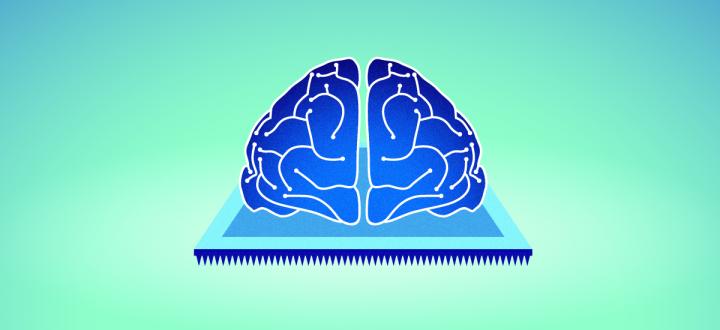Learn about brain health and nootropics to boost brain function
MIPT physicists create device for imitating biological memory


Researchers from the Moscow Institute of Physics and Technology have created a device that acts like a synapse in the living brain, storing information and gradually forgetting it when not accessed for a long time. Known as a second-order memristor, the new device is based on hafnium oxide and offers prospects for designing analog neurocomputers imitating the way a biological brain learns. The findings are reported in ACS Applied Materials & Interfaces.
Neurocomputers, which enable artificial intelligence, emulate the way the brain works. It stores data in the form of synapses, a network of connections between the nerve cells, or neurons. Most neurocomputers have a conventional digital architecture and use mathematical models to invoke virtual neurons and synapses.
Alternatively, an actual on-chip electronic component could stand for each neuron and synapse in the network. This so-called analog approach has the potential to drastically speed up computations and reduce energy costs.
The core component of a hypothetical analog neurocomputer is the memristor. The word is a portmanteau of "memory" and "resistor," which pretty much sums up what it is: a memory cell acting as a resistor. Loosely speaking, a high resistance encodes a zero, and a low resistance encodes a one. This is analogous to how a synapse conducts a signal between two neurons (one), while the absence of a synapse results in no signal, a zero.
But there is a catch: In an actual brain, the active synapses tend to strengthen over time, while the opposite is true for inactive ones. This phenomenon known as synaptic plasticity is one of the foundations of natural learning and memory. It explains the biology of cramming for an exam and why our seldom accessed memories fade.
Proposed in 2015, the second-order memristor is an attempt to reproduce natural memory, complete with synaptic plasticity. The first mechanism for implementing this involves forming nanosized conductive bridges across the memristor. While initially decreasing resistance, they naturally decay with time, emulating forgetfulness.
"The problem with this solution is that the device tends to change its behavior over time and breaks down after prolonged operation," said the study's lead author Anastasia Chouprik from MIPT's Neurocomputing Systems Lab. "The mechanism we used to implement synaptic plasticity is more robust. In fact, after switching the state of the system 100 billion times, it was still operating normally, so my colleagues stopped the endurance test."
Instead of nanobridges, the MIPT team relied on hafnium oxide to imitate natural memory. This material is ferroelectric: Its internal bound charge distribution -- electric polarization -- changes in response to an external electric field. If the field is then removed, the material retains its acquired polarization, the way a ferromagnet remains magnetized.
The physicists implemented their second-order memristor as a ferroelectric tunnel junction -- two electrodes interlaid with a thin hafnium oxide film (fig. 1, right). The device can be switched between its low and high resistance states by means of electric pulses, which change the ferroelectric film's polarization and thus its resistance.
"The main challenge that we faced was figuring out the right ferroelectric layer thickness," Chouprik added. "Four nanometers proved to be ideal. Make it just one nanometer thinner, and the ferroelectric properties are gone, while a thicker film is too wide a barrier for the electrons to tunnel through. And it is only the tunneling current that we can modulate by switching polarization."
What gives hafnium oxide an edge over other ferroelectric materials, such as barium titanate, is that it is already used by current silicon technology. For example, Intel has been manufacturing microchips based on a hafnium compound since 2007. This makes introducing hafnium-based devices like the memristor reported in this story far easier and cheaper than those using a brand-new material.
In a feat of ingenuity, the researchers implemented "forgetfulness" by leveraging the defects at the interface between silicon and hafnium oxide. Those very imperfections used to be seen as a detriment to hafnium-based microprocessors, and engineers had to find a way around them by incorporating other elements into the compound. Instead, the MIPT team exploited the defects, which make memristor conductivity die down with time, just like natural memories.
Vitalii Mikheev, the first author of the paper, shared the team's future plans: "We are going to look into the interplay between the various mechanisms switching the resistance in our memristor. It turns out that the ferroelectric effect may not be the only one involved. To further improve the devices, we will need to distinguish between the mechanisms and learn to combine them."
According to the physicists, they will move on with the fundamental research on the properties of hafnium oxide to make the nonvolatile random access memory cells more reliable. The team is also investigating the possibility of transferring their devices onto a flexible substrate, for use in flexible electronics.
Last year, the researchers offered a detailed description of how applying an electric field to hafnium oxide films affects their polarization. It is this very process that enables reducing ferroelectric memristor resistance, which emulates synapse strengthening in a biological brain. The team also works on neuromorphic computing systems with a digital architecture.
###
Disclaimer: AAAS and EurekAlert! are not responsible for the accuracy of news releases posted to EurekAlert! by contributing institutions or for the use of any information through the EurekAlert system.
Click here to view full article